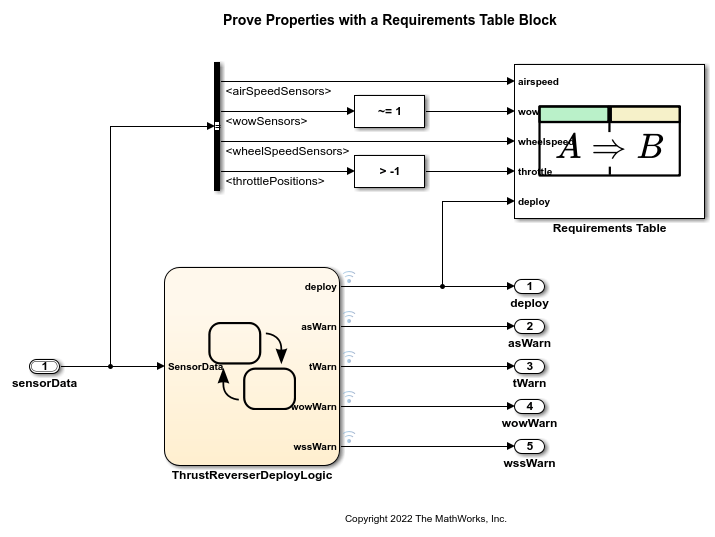使用 Requirements Table 模块证明属性
此示例显示如何使用 Requirements Table 模块和 Simulink® Design Verifier™ 来证明发动机推力反向系统的属性。
当您使用 Requirements Table 模块和 Simulink Design Verifier 进行属性证明时:
模块中的每个需求都定义了一个正式需求,您可以使用它来测试模型、子系统或模块的属性。在此示例中,Requirements Table 模块需求表示为预条件和后条件。
模块中的每个需求都会在需求编辑器中产生一个对应的需求。请参阅配置形式化需求的属性 (Requirements Toolbox)。
Simulink Design Verifier 为需求集集中的需求生成证明目标。后条件定义了您通常在 Proof Objective 模块中定义的逻辑条件。仅当前提条件为真时,该模块才会评估与后置条件相关的证明目标。
有关更多信息,请参阅使用 Requirements Table 模块创建正式需求 (Requirements Toolbox)和使用 Simulink Design Verifier 证明模型属性
查看 Requirements Table 模块中的需求
打开示例模型,property_proving_reqtable。在此示例中,您将测试发动机推力反向系统的属性,该系统由图 ThrustReverserDeployLogic 建模。Requirements Table 模块使用图输入信号和部署输出信号来观察图行为。该模块以表达式定义数据来评估图的输入和输出。请参阅在 Requirements Table 模块中定义数据 (Requirements Toolbox)。

要查看与每个需求相关的验证逻辑,请打开 Requirements Table 模块。这些需求与示例 通过分析模型属性来验证需求 中使用的需求集的需求相对应。该模块证明了以下属性:
如果空速大于 150 节,则推力反向不得展开。
根据车轮重量传感器的数值显示,如果飞机在空中,推力反向不得展开。如果飞机在空中,两个车轮重量 (WOW) 传感器各自的信号值为
false。如果任一推力传感器的值为正,则推力反向不得展开。
如果起落架轮子的转速低于阈值,则推力反向不得展开。
每个需求定义一个属性。如果预条件有效,则后置条件也必须满足才能证明属性。

证明属性
为了证明属性,请在 Design Verifier 选项卡中点击证明属性。在这个示例中,图的属性得到了证明。Requirements Table 模块以绿色突出显示与已证明的证明目标相关的后条件。

如果需求证明目标被证伪,模块会用红色突出显示该需求。否则,如果 Simulink Design Verifier 无法证明或反驳证明目标,则该模块将以黄色突出显示该需求。您可以通过将此示例中的图替换为 通过分析模型属性来验证需求 示例中使用的图的第一次迭代来研究此行为。
另请参阅
Requirements Table (Requirements Toolbox)
主题
- 证明模型中的属性
- 使用 Requirements Table 模块创建正式需求 (Requirements Toolbox)
- 从 Requirements Table 模块生成并导出测试